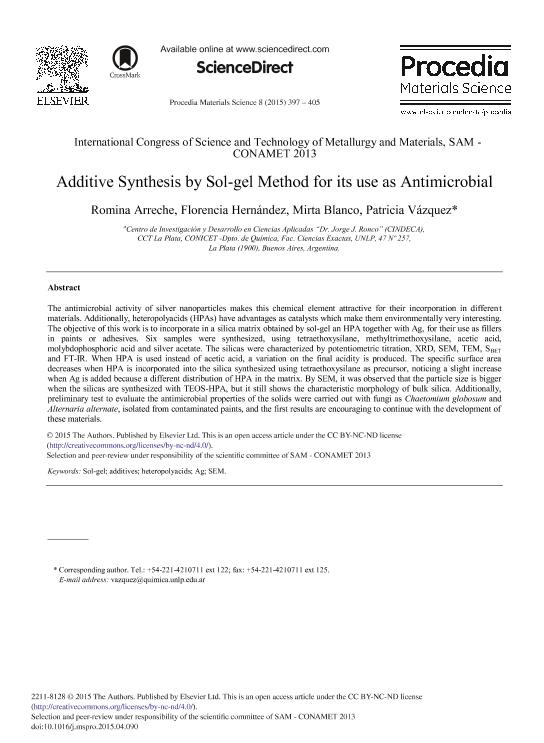Artículo
Additive synthesis by sol-gel method for its use as antimicrobial
Fecha de publicación:
06/2015
Editorial:
Elsevier
Revista:
Procedia Materials Science
ISSN:
2211-8128
Idioma:
Inglés
Tipo de recurso:
Artículo publicado
Clasificación temática:
Resumen
The antimicrobial activity of silver nanoparticles makes this chemical element attractive for their incorporation in different materials. Additionally, heteropolyacids (HPAs) have advantages as catalysts which make them environmentally very interesting. The objective of this work is to incorporate in a silica matrix obtained by sol-gel an HPA together with Ag, for their use as fillers in paints or adhesives. Six samples were synthesized, using tetraethoxysilane, methyltrimethoxysilane, acetic acid, molybdophosphoric acid and silver acetate. The silicas were characterized by potentiometric titration, XRD, SEM, TEM, SBET and FT-IR. When HPA is used instead of acetic acid, a variation on the final acidity is produced. The specific surface area decreases when HPA is incorporated into the silica synthesized using tetraethoxysilane as precursor, noticing a slight increase when Ag is added because a different distribution of HPA in the matrix. By SEM, it was observed that the particle size is bigger when the silicas are synthesized with TEOS-HPA, but it still shows the characteristic morphology of bulk silica. Additionally, preliminary test to evaluate the antimicrobial properties of the solids were carried out with fungi as Chaetomium globosum and Alternaria alternate, isolated from contaminated paints, and the first results are encouraging to continue with the development of these materials.
Palabras clave:
Sol-Gel
,
Additives
,
Heteropolyacids
,
Ag
Archivos asociados
Licencia
Identificadores
Colecciones
Articulos(CETMIC)
Articulos de CENTRO TECNOL.DE REC.MINERALES Y CERAMICA (I)
Articulos de CENTRO TECNOL.DE REC.MINERALES Y CERAMICA (I)
Articulos(CINDECA)
Articulos de CENTRO DE INV EN CS.APLICADAS "DR.JORGE J.RONCO"
Articulos de CENTRO DE INV EN CS.APLICADAS "DR.JORGE J.RONCO"
Citación
Arreche, Romina; Hernández, Maria Florencia; Blanco, Mirta Noemi; Vazquez, Patricia Graciela; Additive synthesis by sol-gel method for its use as antimicrobial; Elsevier; Procedia Materials Science; 8; 6-2015; 397-405
Compartir
Altmétricas




